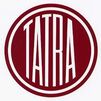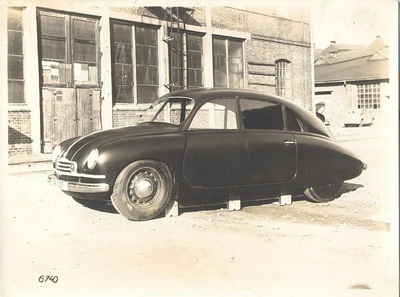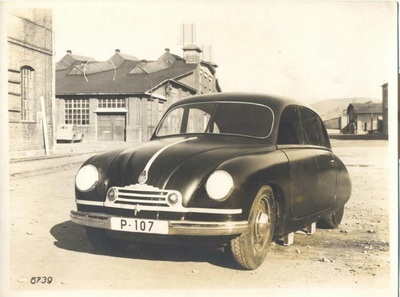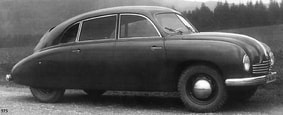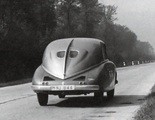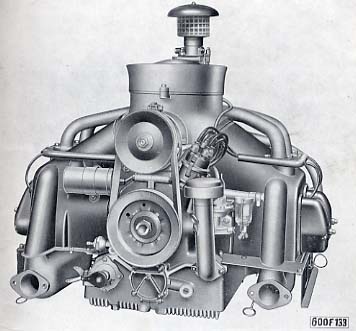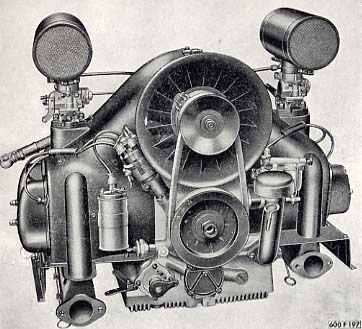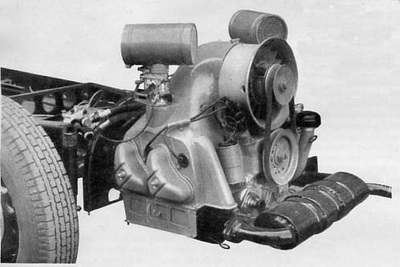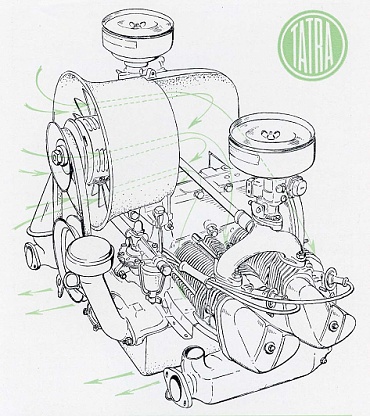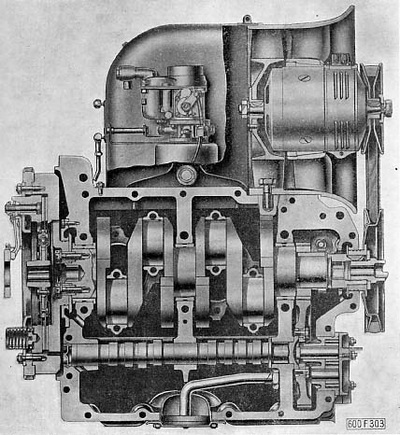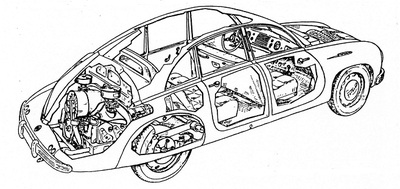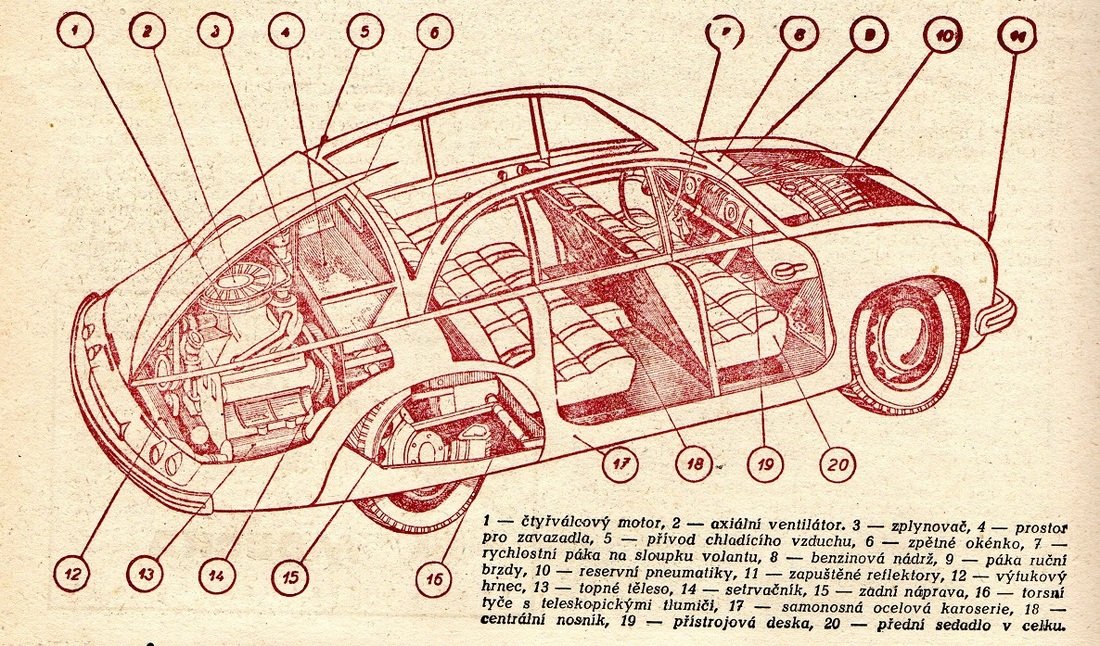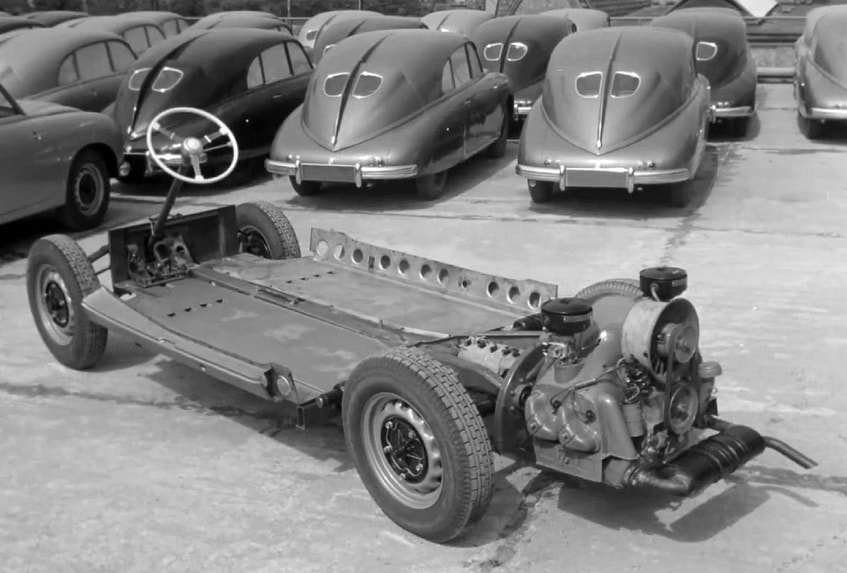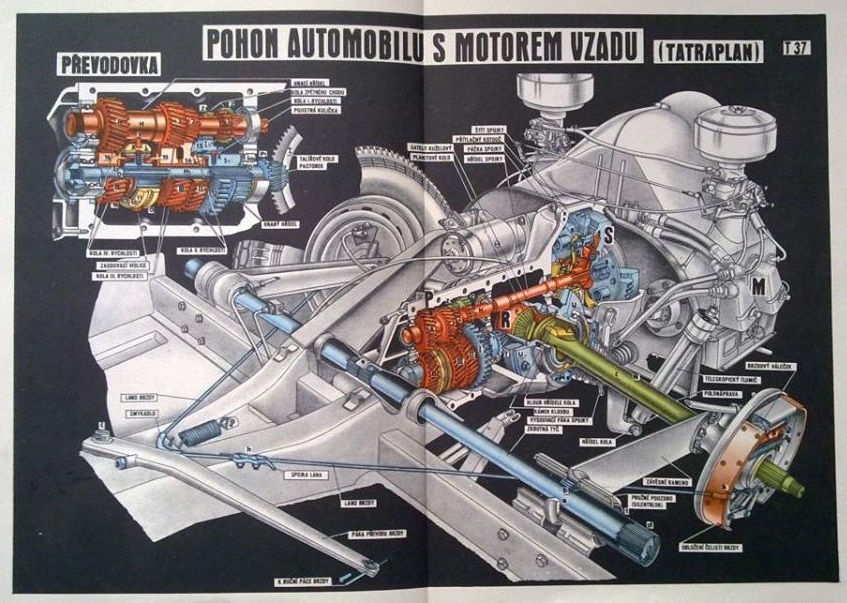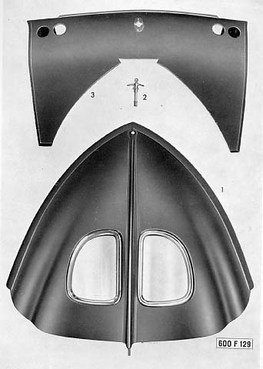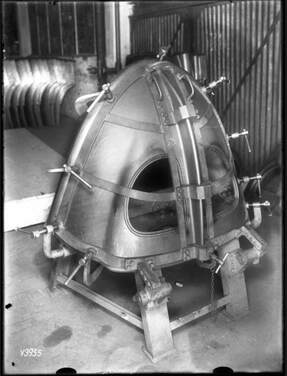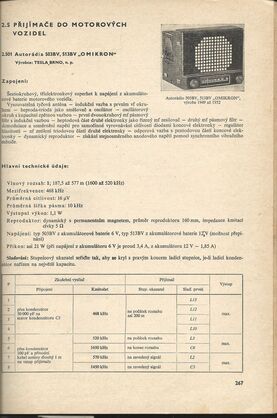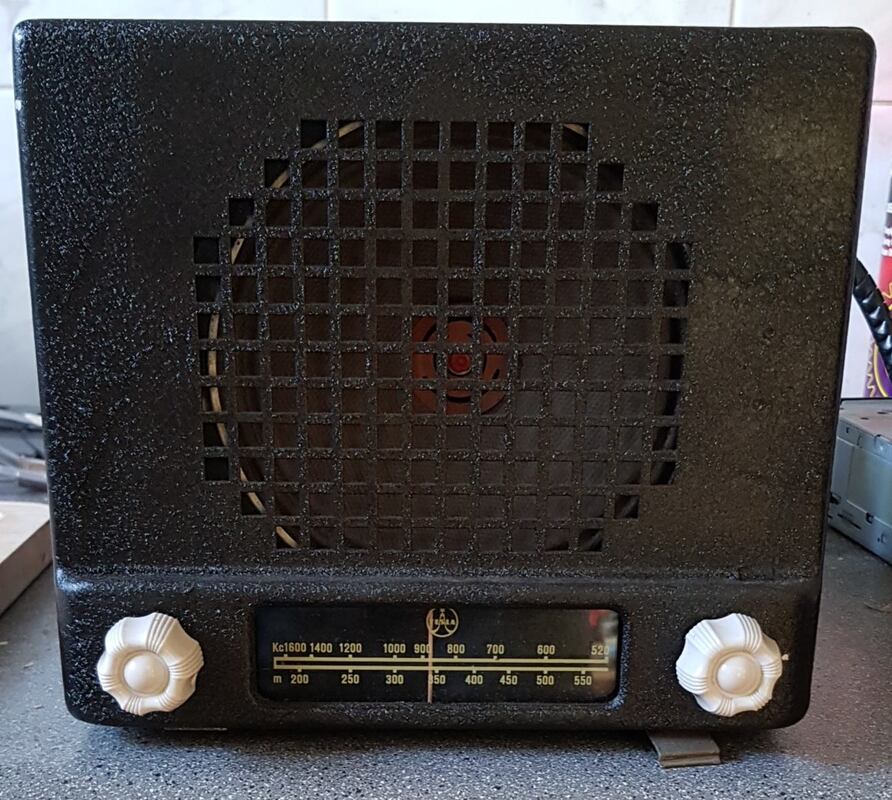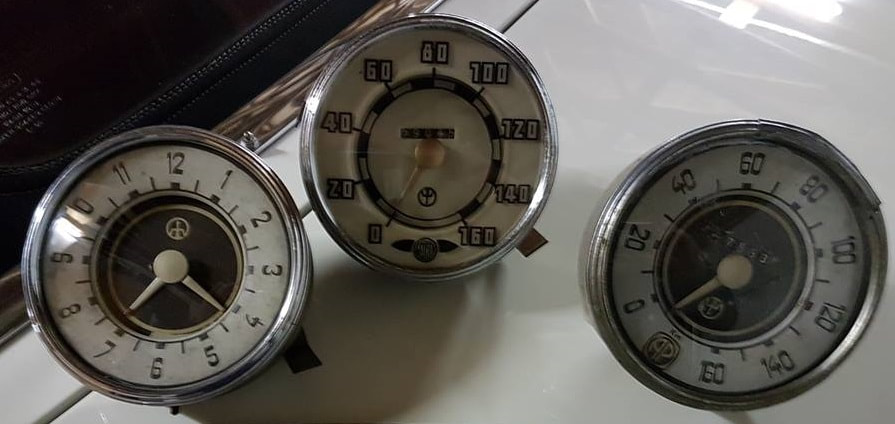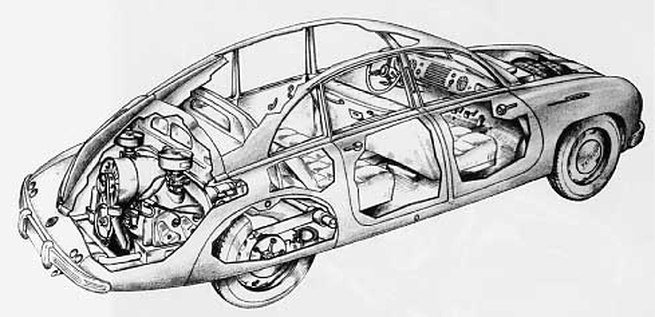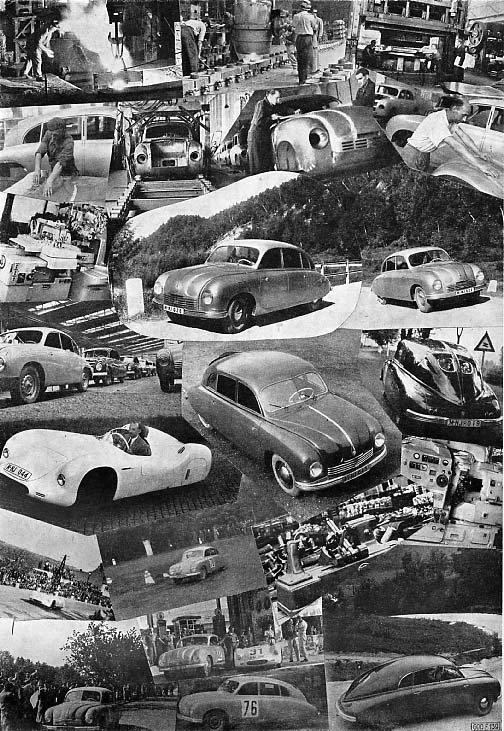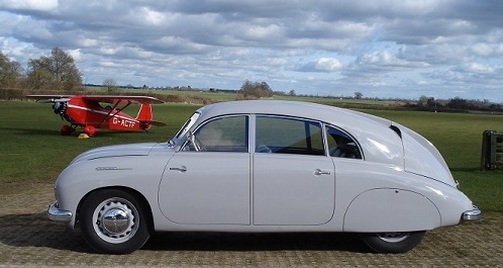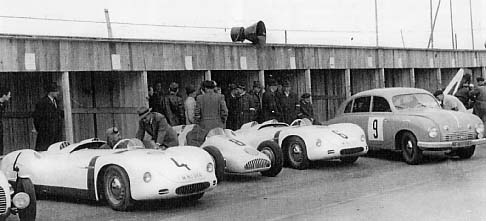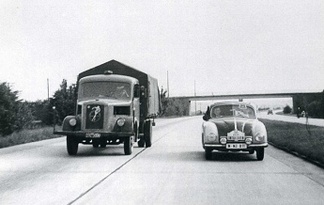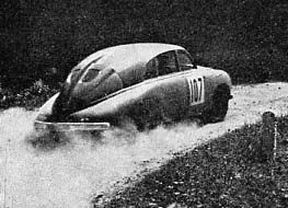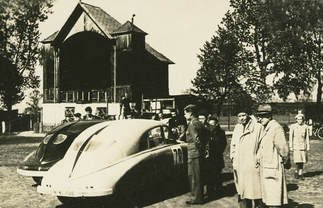Tatra T600 Tatraplan
The Only Fully-Enveloping Mass-Produced Teardrop Car
Text and images : all rights reserved © 2024 www.tatraplan.co.uk
Tatra Type 600 Tatraplan description
For body drag coefficients see below
The Only Fully-Enveloping Mass-Produced Teardrop Car
Text and images : all rights reserved © 2024 www.tatraplan.co.uk
Tatra Type 600 Tatraplan description
For body drag coefficients see below
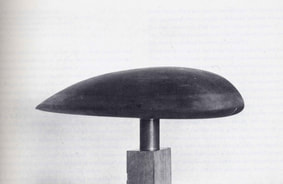
Paul Jaray (1889–1974): 'Ideal streamlined form for a body close to the ground', c. 1920, model.
Courtesy of ETH Library, History of Science Collection, Zurich, Switzerland
Courtesy of ETH Library, History of Science Collection, Zurich, Switzerland
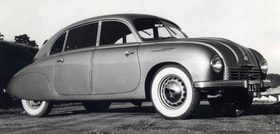
Tatra Type 600 Tatraplan matches Jaray's ideal form the closest of any other serially produced automobile.
Manufacturer: Tatra, národní podnik, Kopřivnice, Moravia, Czechoslovakia, now the Czech Republic
Design: Josef Chalupa, Vladimír Popelář (1915-97), František Kardaus (1908-86), Hans Ledwinka (1878-1967)
Engine and gearbox design: Jiří Klos (1921-2009)
Design: Josef Chalupa, Vladimír Popelář (1915-97), František Kardaus (1908-86), Hans Ledwinka (1878-1967)
Engine and gearbox design: Jiří Klos (1921-2009)
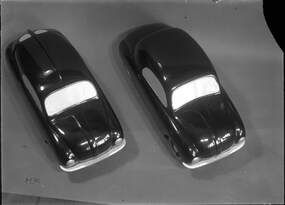
Early wooden study models, 1946.
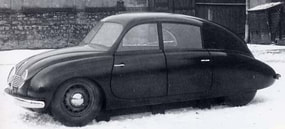
First Tatra T107 'Ambrož' prototype mockup, air intakes behind rear side windows, December 1946. (Possible inspiration was the Saab Ursaab 92001, completed in April 1946, although this car had a front positioned transverse water-cooled, two-stroke, two-cylinder DKW 692cc engine of 20hp driving the front wheels; 20 prototypes made before series production started in December 1949).
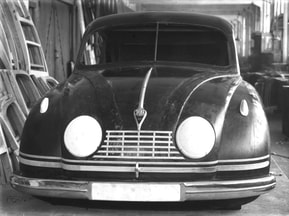
Front view of Tatra T107 'Ambrož', December 1946.
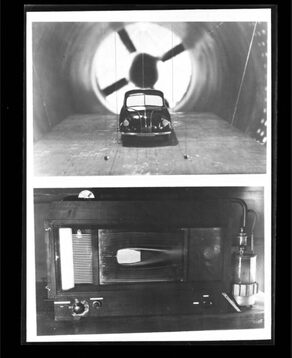
Wind tunnel test of a model of an early prototype, Letňany, Prague.
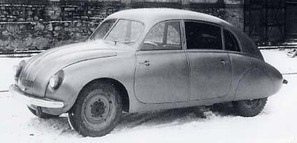
Second Tatra T107 'Josef' prototype, air intakes behind rear side windows, January - March 1947.
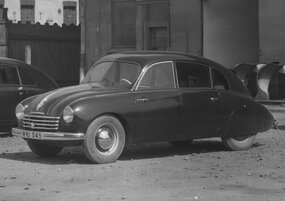
Tatraplan prototype variation with partly recessed headlamps, no fender badges, air intakes behind rear side windows and at roof, spring/summer 1947.
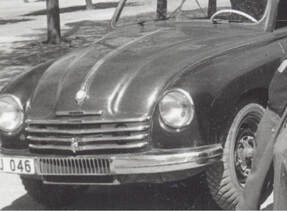
Another Tatraplan prototype variation with a front bumper grille, dropped floor pan opening at the front, circular and rectangular openings behind the front chrome strips and partly recessed headlamps, no fender badges, spring/summer 1947.
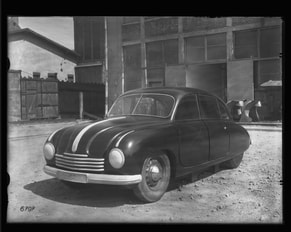
Wooden T2-107 mockup for the production model without air intakes.
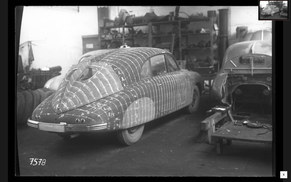
Tatraplan mockup of a third prototype with dimension lines, 1947.
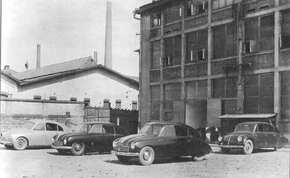
'Josef' prototype with the T2–107 mockup, and the third final prototype, and a T97, 1947. The front of the 1947 T2–107 body to the post between the front and rear doors was designed by František Kardaus of Studio Burjanek a Remo (B a R), the first industrial designer involved with Tatra car bodies proposals. First introduced at Prague Autosalon, 18-28 October, 1947. The car was initially named 'Autoplan' then Kardaus, it is claimed, named it 'Tatraplan', the name registered on 11 December 1947.
T2–107 Tatraplan 1947 (T2–107, type designation changed to T600 [T=Type 600] at the end of 1947). Pictured the T2–107 [third and final prototype, one of five units] made on 6/9/1947 intended for the autumn 1947 Prague Autosalon.
Serial manufacture: 1948–1951 in Tatra, Kopřivnice, 1951–1952 in Škoda, Mladá Boleslav.
Number made including 2 (T107) + 5 (T2-107) prototypes: 6342 (4242 in Kopřivnice, 2100 in Mladá Boleslav).
Exported numbers of units from Kopřivnice only (Mladá Boleslav figures in preparation):
Austria: 435, China: 200, West Germany: 195, Sweden: 184 (LHD only), Finland: 248, Canada: 168, Belgium: 167, Switzerland: 153, Hungary: 146, USSR: 126, Poland: 97, Yugoslavia: 76, The Netherlands: 60, East Germany: 46, Egypt: 45, Morocco: 29, Albania: 20, Romania: 17, Portugal: 1, Australia (RHD): tbc, Indonesia (RHD): tbc, Ceylon (RHD): tbc, Pakistan (RHD): tbc, Malaya (RHD): tbc, Kenya (RHD): tbc, Cyprus (RHD): tbc, Ethiopia (RHD): tbc, South Africa (RHD): tbc, Sudan: tbc, Argentina: tbc.
Special exports for use by Czechoslovak and East block embassies: tbc.
First series manufacture started on 24 June 1948.
Initially the selling price was established at 130,000 Czechoslovak crowns (approx £930 / US $2600 in 1948),
soon increasing to 140,000 Czechoslovak crowns (approx £1000 / US $2800).
Prototypes:
T107 two prototype units: 70.020 – 70.021, each with a 1729cc 80mm x 86mm with an axial fan on vertical shaft, one carburetter engine.
T2-107 five final prototype units: 70.022 – 70.026 each with a 1952cc 85mm x 86mm with an axial fan on vertical shaft, one carburetter engine. These engines were also installed in the first series.
First series body numbers: 70.027 – 70.876, subsequent series: 70.877 – 76.867 (Kopřivnice, 1948: 90, 1949: 1506, 1950: 2025, 1951: 614 units) [70.877 – 70.926, 71.029 – 71.032, 71.035, 71.037 – 71.044, 71.047 – 71.055, 71.060 – 71.070, 71.072 – 71.082, 71.086 – 72.281, 74.730 – 75.126, – 76.867], officially the last car was produced there on 25 May, 1951 although some units might have been made there up to October 1951 such as 76.411 and 76.408 (some numbers were used out of chronological sequence).
25th to 29th series (Škoda numbered series): 179.001 – 181.100 (Mladá Boleslav, 1951: 236, 1952: 1,864 units) from October 29, 1951 to June 1952.
Another source gives the following information from Kopřivnice production:
1. series: 70.027 – 70.126 June 1948 – January 1949, 2. series: 70.127 – 70.626 January 1949 – July 1949,
3. series: 70.627 – 71.126 June 1949 – October 1949, 4. series: 71.127 – 72.126 November 1949 – July 1950,
5. series: 74.733 – 75.732 May 1950 – March 1951, 6. series: 75.733 – 76.732 February 1951 – October 1951,
7. series: 76.733 – 76.867 April 1951 – September 1951
First series 70.027 – 70.876 engine numbers: 600.1.85.48 to 600.853.85.49 had a 1952cc 85mm bore, 86mm stroke flat four engine with an axial fan on vertical shaft and one carburetter; from the body number 70.877 engine numbers 600.854.85.49 to 600.5103.85.51 (manufactured from the summer of 1949) had an engine with a fan on horizontal shaft and two carburetters. The manufacturing label stated: 'Tatra, národní podnik, Závod Kopřivnice'.
Škoda Mladá Boleslav manufacture series 179.001 – 181.100 had the latter engines with the same engine numbers as the body numbers and the manufacturing label stated: 'Automobilové závody, národní podnik, Závod Mladá Boleslav - ČSR'.
Engine number explained: first number: Tatra type, second number: engine number, third number: cylinder bore, forth number: year of manufacture. If the manufacturing label is missing, the body number can be found on the side of the engine block and/or under the front bonnet along the top edge above the fuel tank on the right looking from the front. The engine number is stamped on the engine block.
Number made including 2 (T107) + 5 (T2-107) prototypes: 6342 (4242 in Kopřivnice, 2100 in Mladá Boleslav).
Exported numbers of units from Kopřivnice only (Mladá Boleslav figures in preparation):
Austria: 435, China: 200, West Germany: 195, Sweden: 184 (LHD only), Finland: 248, Canada: 168, Belgium: 167, Switzerland: 153, Hungary: 146, USSR: 126, Poland: 97, Yugoslavia: 76, The Netherlands: 60, East Germany: 46, Egypt: 45, Morocco: 29, Albania: 20, Romania: 17, Portugal: 1, Australia (RHD): tbc, Indonesia (RHD): tbc, Ceylon (RHD): tbc, Pakistan (RHD): tbc, Malaya (RHD): tbc, Kenya (RHD): tbc, Cyprus (RHD): tbc, Ethiopia (RHD): tbc, South Africa (RHD): tbc, Sudan: tbc, Argentina: tbc.
Special exports for use by Czechoslovak and East block embassies: tbc.
First series manufacture started on 24 June 1948.
Initially the selling price was established at 130,000 Czechoslovak crowns (approx £930 / US $2600 in 1948),
soon increasing to 140,000 Czechoslovak crowns (approx £1000 / US $2800).
Prototypes:
T107 two prototype units: 70.020 – 70.021, each with a 1729cc 80mm x 86mm with an axial fan on vertical shaft, one carburetter engine.
T2-107 five final prototype units: 70.022 – 70.026 each with a 1952cc 85mm x 86mm with an axial fan on vertical shaft, one carburetter engine. These engines were also installed in the first series.
First series body numbers: 70.027 – 70.876, subsequent series: 70.877 – 76.867 (Kopřivnice, 1948: 90, 1949: 1506, 1950: 2025, 1951: 614 units) [70.877 – 70.926, 71.029 – 71.032, 71.035, 71.037 – 71.044, 71.047 – 71.055, 71.060 – 71.070, 71.072 – 71.082, 71.086 – 72.281, 74.730 – 75.126, – 76.867], officially the last car was produced there on 25 May, 1951 although some units might have been made there up to October 1951 such as 76.411 and 76.408 (some numbers were used out of chronological sequence).
25th to 29th series (Škoda numbered series): 179.001 – 181.100 (Mladá Boleslav, 1951: 236, 1952: 1,864 units) from October 29, 1951 to June 1952.
Another source gives the following information from Kopřivnice production:
1. series: 70.027 – 70.126 June 1948 – January 1949, 2. series: 70.127 – 70.626 January 1949 – July 1949,
3. series: 70.627 – 71.126 June 1949 – October 1949, 4. series: 71.127 – 72.126 November 1949 – July 1950,
5. series: 74.733 – 75.732 May 1950 – March 1951, 6. series: 75.733 – 76.732 February 1951 – October 1951,
7. series: 76.733 – 76.867 April 1951 – September 1951
First series 70.027 – 70.876 engine numbers: 600.1.85.48 to 600.853.85.49 had a 1952cc 85mm bore, 86mm stroke flat four engine with an axial fan on vertical shaft and one carburetter; from the body number 70.877 engine numbers 600.854.85.49 to 600.5103.85.51 (manufactured from the summer of 1949) had an engine with a fan on horizontal shaft and two carburetters. The manufacturing label stated: 'Tatra, národní podnik, Závod Kopřivnice'.
Škoda Mladá Boleslav manufacture series 179.001 – 181.100 had the latter engines with the same engine numbers as the body numbers and the manufacturing label stated: 'Automobilové závody, národní podnik, Závod Mladá Boleslav - ČSR'.
Engine number explained: first number: Tatra type, second number: engine number, third number: cylinder bore, forth number: year of manufacture. If the manufacturing label is missing, the body number can be found on the side of the engine block and/or under the front bonnet along the top edge above the fuel tank on the right looking from the front. The engine number is stamped on the engine block.
Engine: flat four cylinder (boxer) OHV, petrol, four stroke, at rear
Bore: 85mm
Stroke: 86mm
Capacity: 1952cc
Power output: 52bhp (RAC tax horse-power rating: 17.9)
Torque: 118Nm (12mkg, 89ft/lb) / 2000rev
Compression ratio: 6:1
Maximum revs: 4000 1/min
Acceleration: 0-80km/h (50mph) 22sec
Valve clearances: inlet: 0,1mm - exhaust: 0,15mm
Carburetters: downdraught Zenith IMF, 1 no. or Solex 32 UBIP, 1 no. or 2 no. or Jikov 32 SOP, 1 no. or 2 no.
Petrol pump: Solex AP 41-294-411 with glass bowl below for the older engines, Solex DP 31-294-330 with glass bowl on top for the newer engines
Firing order: 1, 4, 3, 2 (looking from the rear: RH rear 2, RH 1 front, LH 4 rear, LH 3 front)
Sparking plugs: PAL 14/175, Champion I 10 con, Bosch 175 T1 (modern: NGK BP6HS, Yttrium Super or Brisk Super N15YC), 0.5 - 0.7mm electrode clearance
Cooling: forced air draught by axial cooling fan
V belt: 17 x 850mm, allow 10mm deflection to prevent damage to the pulley
The petrol engine has aluminium cylinder heads and hemispherical combustion chambers. Valves are not inclined as much as in the Tatra T87 and are actuated by crossed rockers and operated by aluminium push-rods from a single camshaft placed in the aluminium crankcase below the crankshaft. The crankcase is split in the plane of the crankshaft. Both halves in which the main bearings are mounted are bolted together. The camshaft is driven from the front end of the crankshaft through gear pinions and the ignition distributor through worm gears. The distributor shaft incorporates a fuel pump drive cam.
The lubricating oil pump is driven by the front end of the camshaft, the supply of oil being stored in the finned crankcase. Oil is forced from the pump through the oil cooler mounted in the front part of the car and, through a multi-edge cleaner to the lubricated parts. By-pass pressure valves are provided at the cooler and cleaner.
The short-stroke engine develops 26bhp per litre which is the same specific output as that of the Tatra T87 (8 cyl, 2,958cc, 75bhp). Originally the engine had an axial fan with a vertical shaft driven by a bevel gear. On the later design a horizontal axis fan was mounted directly to the dynamo shaft driven by a V belt. The long manifold piping of the original design was eliminated by using two carburettors and performance increased to 52bhp.
Engine bolts torque settings:
6mm bolts: 12Nm
8mm bolts: 18-20Nm
10mm bolts: 30Nm, cylinder heads not to be tightened more, otherwise they will distort!
Conrod big end bolts: 30-35Nm
Clutch: dry one-plate
Gear shift: steering column mounted
Gearbox: mechanical 4-speed plus reverse
Gears: four with synchronisation on 2, 3 and 4
Front springing: independent, by double transverse leaf-springs, with greased felt interlayers
Rear springing: independent, by torsion bars
Shock absorbers: front and rear telescopic hydraulic dampers
Steering: rack and pinion
Steering wheel: 450mm dia, three spokes with five rods each, gear lever hub under, gear lever on steering column arrangement
Brakes: drums, hydraulic on all four wheels
Brake fluid: Dot 3 yellow
Engine oil: 9.5 litres including in the front cooler, (5.5 litres in the engine) mineral oil SAE 15W-50, 20W-50 or similar only, operating sump oil temperature: 60 to 75 degrees C
Gearbox oil: 3.5 litres, mineral oil SAE 90 or similar only.
Engine oil consumption: 0.2 litres per 100km
Engine oil pressure: 4 – 5 atm (bar)
Bore: 85mm
Stroke: 86mm
Capacity: 1952cc
Power output: 52bhp (RAC tax horse-power rating: 17.9)
Torque: 118Nm (12mkg, 89ft/lb) / 2000rev
Compression ratio: 6:1
Maximum revs: 4000 1/min
Acceleration: 0-80km/h (50mph) 22sec
Valve clearances: inlet: 0,1mm - exhaust: 0,15mm
Carburetters: downdraught Zenith IMF, 1 no. or Solex 32 UBIP, 1 no. or 2 no. or Jikov 32 SOP, 1 no. or 2 no.
Petrol pump: Solex AP 41-294-411 with glass bowl below for the older engines, Solex DP 31-294-330 with glass bowl on top for the newer engines
Firing order: 1, 4, 3, 2 (looking from the rear: RH rear 2, RH 1 front, LH 4 rear, LH 3 front)
Sparking plugs: PAL 14/175, Champion I 10 con, Bosch 175 T1 (modern: NGK BP6HS, Yttrium Super or Brisk Super N15YC), 0.5 - 0.7mm electrode clearance
Cooling: forced air draught by axial cooling fan
V belt: 17 x 850mm, allow 10mm deflection to prevent damage to the pulley
The petrol engine has aluminium cylinder heads and hemispherical combustion chambers. Valves are not inclined as much as in the Tatra T87 and are actuated by crossed rockers and operated by aluminium push-rods from a single camshaft placed in the aluminium crankcase below the crankshaft. The crankcase is split in the plane of the crankshaft. Both halves in which the main bearings are mounted are bolted together. The camshaft is driven from the front end of the crankshaft through gear pinions and the ignition distributor through worm gears. The distributor shaft incorporates a fuel pump drive cam.
The lubricating oil pump is driven by the front end of the camshaft, the supply of oil being stored in the finned crankcase. Oil is forced from the pump through the oil cooler mounted in the front part of the car and, through a multi-edge cleaner to the lubricated parts. By-pass pressure valves are provided at the cooler and cleaner.
The short-stroke engine develops 26bhp per litre which is the same specific output as that of the Tatra T87 (8 cyl, 2,958cc, 75bhp). Originally the engine had an axial fan with a vertical shaft driven by a bevel gear. On the later design a horizontal axis fan was mounted directly to the dynamo shaft driven by a V belt. The long manifold piping of the original design was eliminated by using two carburettors and performance increased to 52bhp.
Engine bolts torque settings:
6mm bolts: 12Nm
8mm bolts: 18-20Nm
10mm bolts: 30Nm, cylinder heads not to be tightened more, otherwise they will distort!
Conrod big end bolts: 30-35Nm
Clutch: dry one-plate
Gear shift: steering column mounted
Gearbox: mechanical 4-speed plus reverse
Gears: four with synchronisation on 2, 3 and 4
Front springing: independent, by double transverse leaf-springs, with greased felt interlayers
Rear springing: independent, by torsion bars
Shock absorbers: front and rear telescopic hydraulic dampers
Steering: rack and pinion
Steering wheel: 450mm dia, three spokes with five rods each, gear lever hub under, gear lever on steering column arrangement
Brakes: drums, hydraulic on all four wheels
Brake fluid: Dot 3 yellow
Engine oil: 9.5 litres including in the front cooler, (5.5 litres in the engine) mineral oil SAE 15W-50, 20W-50 or similar only, operating sump oil temperature: 60 to 75 degrees C
Gearbox oil: 3.5 litres, mineral oil SAE 90 or similar only.
Engine oil consumption: 0.2 litres per 100km
Engine oil pressure: 4 – 5 atm (bar)
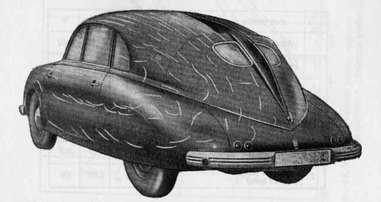
Body: streamlined fully self-supporting steel monocoque, smooth underside with welded-in backbone member; export units had rear fender skirts/spats made in aluminium.
Before and during the Second World War Tatra Works measured only 1:5 and 1:10 models at the Aircraft Research and Testing Institute Praha–Letňany, at German Research Institute for Aviation Adlershof, at University of Stuttgart, and after the War 1:1 size models/cars at VW Klima wind tunnel (1979):
Body drag coefficient Cd (Cx):
Tatra T600: 1:5 = 0.24 (tunnel), 1:1 = 0.33 (road), 1:1 = 0.32 (tunnel);
For comparison:
Tatra T57: 1:5 model = 0.735 [1936];
Tatra T77: 1:5 model = 0.245 [1936], 1:1 = 0.36 [estimated, never tested];
Tatra T77a: 1:1 = 0.36 [estimated, never tested]; (0.212 quoted in other sources for the T77a possibly relates to a T77 1:10 1934 Jaray model test or a T87 1:10 model test, although as yet the sources cannot be ascertained, see below). The Jaray 1:10 model had a curved windscreen which would greatly improve the result.
Tatra T87: 1:10 model = 0.251, 1:5 model = 0.244, 1:1 = 0.36; (Erich Ledwinka quoted 0.212 for the T87 in his lecture about Hans Ledwinka, see ‘Leben und Werk des Automobilpioniers Dr. tech. h.c. Hans Ledwinka’, as spoken by Erich Ledwinka at Akademischen Feier der Technischen Universität Wien on May 19th, 1978, published in Blätter für Technikgeschichte 39/40 Heft, Springer Verlag, Wien, 1980, p. 151.)
Tatra T97: 1:10 model = 0.259
NOTE: Real full size car test always have higher readings than the small car model tests. The Tatra car streamlined bodies are essentially of the same design, hence the drag coefficient range is similar for the 1:5, 1:10 models and the full-size cars (models: 0.21 to 0.26, full-size cars: 0.32 to 0.37).
Percentages of total drag created by: the frontal part of car 32%, the rest of the exterior 33%, the car underside 35%.
Hence the importance of smooth underside in streamlined car body designs.
Before and during the Second World War Tatra Works measured only 1:5 and 1:10 models at the Aircraft Research and Testing Institute Praha–Letňany, at German Research Institute for Aviation Adlershof, at University of Stuttgart, and after the War 1:1 size models/cars at VW Klima wind tunnel (1979):
Body drag coefficient Cd (Cx):
Tatra T600: 1:5 = 0.24 (tunnel), 1:1 = 0.33 (road), 1:1 = 0.32 (tunnel);
For comparison:
Tatra T57: 1:5 model = 0.735 [1936];
Tatra T77: 1:5 model = 0.245 [1936], 1:1 = 0.36 [estimated, never tested];
Tatra T77a: 1:1 = 0.36 [estimated, never tested]; (0.212 quoted in other sources for the T77a possibly relates to a T77 1:10 1934 Jaray model test or a T87 1:10 model test, although as yet the sources cannot be ascertained, see below). The Jaray 1:10 model had a curved windscreen which would greatly improve the result.
Tatra T87: 1:10 model = 0.251, 1:5 model = 0.244, 1:1 = 0.36; (Erich Ledwinka quoted 0.212 for the T87 in his lecture about Hans Ledwinka, see ‘Leben und Werk des Automobilpioniers Dr. tech. h.c. Hans Ledwinka’, as spoken by Erich Ledwinka at Akademischen Feier der Technischen Universität Wien on May 19th, 1978, published in Blätter für Technikgeschichte 39/40 Heft, Springer Verlag, Wien, 1980, p. 151.)
Tatra T97: 1:10 model = 0.259
NOTE: Real full size car test always have higher readings than the small car model tests. The Tatra car streamlined bodies are essentially of the same design, hence the drag coefficient range is similar for the 1:5, 1:10 models and the full-size cars (models: 0.21 to 0.26, full-size cars: 0.32 to 0.37).
Percentages of total drag created by: the frontal part of car 32%, the rest of the exterior 33%, the car underside 35%.
Hence the importance of smooth underside in streamlined car body designs.
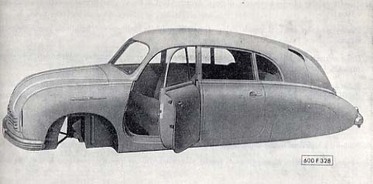
Body types: saloon (Tatra T600, rear engine), coupé, cabriolet. Ambulance, van and pick-up (Tatra T201, front engine), see below. Due to limiting size of steel panel presses the roof was made out of two panel parts that were welded together.
Body colour range available between 1948 – 1951:
light blue, dark blue, black, light green, green, dark green, red, dark red, beige, grey, silver metallic grey, ivory, light brown, brown, metallic blue, metallic light blue, metallic green, metallic red, metallic silver, yellow (special racing colour).
The factory paint numbers refer to 'Materna' paint range which no longer exist.
To match to RAL numbers use a RAL swatch comparing the existing car colour to the nearest swatch colour.
Combinations of body with roof and bonnets: ivory and light brown, ivory and dark red, metallic silver and navy blue, metallic silver and dark red, light blue and dark metallic blue, light green and dark green.
Interior cloth colours: light red, light grey-brown, light green, red, green, blue, grey-brown.
Interior leather colours for export only: beige, brown, red, green.
In some units seats had a combination of leather and cloth.
In the latter series the chrome work and wheel hubs were supplied by the factory with red paint highlighted 'Tatraplan' signs and red painted grooves on bumpers.
Body colour range available between 1948 – 1951:
light blue, dark blue, black, light green, green, dark green, red, dark red, beige, grey, silver metallic grey, ivory, light brown, brown, metallic blue, metallic light blue, metallic green, metallic red, metallic silver, yellow (special racing colour).
The factory paint numbers refer to 'Materna' paint range which no longer exist.
To match to RAL numbers use a RAL swatch comparing the existing car colour to the nearest swatch colour.
Combinations of body with roof and bonnets: ivory and light brown, ivory and dark red, metallic silver and navy blue, metallic silver and dark red, light blue and dark metallic blue, light green and dark green.
Interior cloth colours: light red, light grey-brown, light green, red, green, blue, grey-brown.
Interior leather colours for export only: beige, brown, red, green.
In some units seats had a combination of leather and cloth.
In the latter series the chrome work and wheel hubs were supplied by the factory with red paint highlighted 'Tatraplan' signs and red painted grooves on bumpers.
Tatraplan rear lid shape history:
70.027 – 70.876: pointed rear lid, flat glass, part 600.21.0000 (1948-9)
70.877 – 75.732: pointed rear lid, flat glass, part 600.21.0100 (1950-51)
75.733 (some units even with earlier numbers) – 76.867: rounded rear lid, shaped larger glass, part 600.21.0100/2 (1951)
(all above at Tatra Kopřivnice, the rounded lid already designed and installed at Tatra)
179.001 – 181.100: rounded rear lid, shaped larger glass, part 13-001-98831 (1951–52 Škoda Mladá Boleslav)
The internal glazed panel size in the rear bulkhead of the lift-able panel above the rear seat increased when the rounded rear lids with larger window openings were installed to improve the rear view.
It is recommend to fix another low positioned rear view mirror onto the centre of dashboard to gain a long-distance rear view from the driver's position.
70.027 – 70.876: pointed rear lid, flat glass, part 600.21.0000 (1948-9)
70.877 – 75.732: pointed rear lid, flat glass, part 600.21.0100 (1950-51)
75.733 (some units even with earlier numbers) – 76.867: rounded rear lid, shaped larger glass, part 600.21.0100/2 (1951)
(all above at Tatra Kopřivnice, the rounded lid already designed and installed at Tatra)
179.001 – 181.100: rounded rear lid, shaped larger glass, part 13-001-98831 (1951–52 Škoda Mladá Boleslav)
The internal glazed panel size in the rear bulkhead of the lift-able panel above the rear seat increased when the rounded rear lids with larger window openings were installed to improve the rear view.
It is recommend to fix another low positioned rear view mirror onto the centre of dashboard to gain a long-distance rear view from the driver's position.
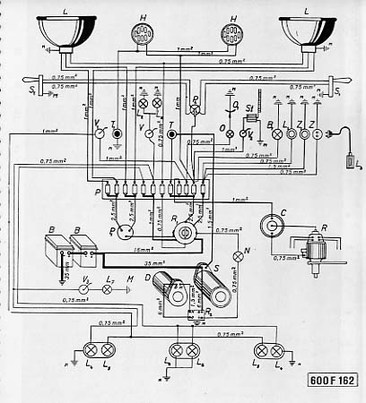
Electrics:
Coil: Magneton 12V CED 01
Starter: PAL 1.8 12V, left-turning
Regulator: Magneton RAD 02 12V 150W
Battery: Varta 12V 75 Ah
Distributor: Magneton VBG 08, right-turning, points gap: 0.3 - 0.4mm
Dynamo: Magneton 12V 150W
Trafficators: PALUX 12V, 94.11 S 10.460, trafficator arm: 210mm long, 17mm wide
Bulbs: main beam headlamp bulbs 12V 35/35W BA 20d
Radio: Tesla Omikron 513 BV 12V was fitted to order, 35W consumption, cost when new 9500Kč, see below
Coil: Magneton 12V CED 01
Starter: PAL 1.8 12V, left-turning
Regulator: Magneton RAD 02 12V 150W
Battery: Varta 12V 75 Ah
Distributor: Magneton VBG 08, right-turning, points gap: 0.3 - 0.4mm
Dynamo: Magneton 12V 150W
Trafficators: PALUX 12V, 94.11 S 10.460, trafficator arm: 210mm long, 17mm wide
Bulbs: main beam headlamp bulbs 12V 35/35W BA 20d
Radio: Tesla Omikron 513 BV 12V was fitted to order, 35W consumption, cost when new 9500Kč, see below
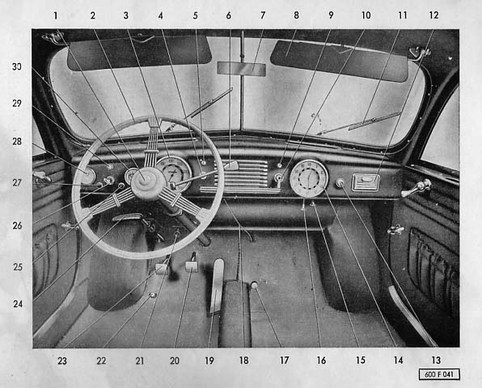
Dashboard instruments:
white face, grey figures with black outlines etched on flat glass, by VDO / Křižík (K), Autopal (AP), PAL, or Technometra (T) (1948–51, approx. 4000 units), fuel and oil temperature gauges by PAL or VDO: white face, black figures on glass, different graphics as large instruments, flat glass;
or
beige face, brown centre, brown figures printed on metal face, convex glass, by Autopal (AP) or Technometra (T), Praha (1951–52, approx. 2340 units, used in the last Kopřivnice series and Škoda production), fuel and oil temperature gauges by Technometra: beige face, brown centre, brown figures printed on metal face, same graphics as large instruments, convex glass.
Clock movement: Cortebert (Switzerland), 8 day
See the photo below for the two types of instruments.
white face, grey figures with black outlines etched on flat glass, by VDO / Křižík (K), Autopal (AP), PAL, or Technometra (T) (1948–51, approx. 4000 units), fuel and oil temperature gauges by PAL or VDO: white face, black figures on glass, different graphics as large instruments, flat glass;
or
beige face, brown centre, brown figures printed on metal face, convex glass, by Autopal (AP) or Technometra (T), Praha (1951–52, approx. 2340 units, used in the last Kopřivnice series and Škoda production), fuel and oil temperature gauges by Technometra: beige face, brown centre, brown figures printed on metal face, same graphics as large instruments, convex glass.
Clock movement: Cortebert (Switzerland), 8 day
See the photo below for the two types of instruments.
|
1 horn
2 steering wheel 3 speedometer 4 choke 5 wipers switch 6 gear lever 7 rear view mirror 8 sun shield 9 instruments lights switch 10 indicators switch |
11 wipers
12 ashtray 13 lighter 14 clock 15 ventilation control 16 clock winder 17 centralised lubrication pedal 18 choke cable 19 gas pedal 20 brake pedal |
21 fuel stop cock
22 headlamps switch 23 clutch pedal 24 handbrake 25 red dynamo and ignition control lamp 26 ignition key 27 green oil pressure control lamp 28 fuel gauge 29 starter button 30 sump oil temperature gauge |

Tyre size: 6,00" – 16", cross ply or radial, front: 1.5bar (22psi), rear: 1.8bar (26psi) (radials should be inflated by approx. 0.3 [4.5psi] to 0.5bar [7.25psi] more)
Rim size: E 4,00" – 16"
Front and Rear Track: 1300mm
Wheelbase: 2700mm
Overall length: 4540mm
Overall width: 1670mm
Overall height: 1520mm
Fuel consumption: 11 litres / 100km (26 miles per gallon)
Weight: 1200kg
Top speed: 130km/h (80 mph)
Tank capacity: 56 litres
Road clearance: 225 mm
Rim size: E 4,00" – 16"
Front and Rear Track: 1300mm
Wheelbase: 2700mm
Overall length: 4540mm
Overall width: 1670mm
Overall height: 1520mm
Fuel consumption: 11 litres / 100km (26 miles per gallon)
Weight: 1200kg
Top speed: 130km/h (80 mph)
Tank capacity: 56 litres
Road clearance: 225 mm
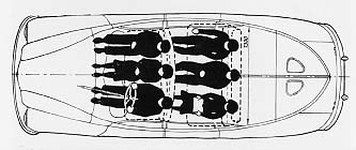
Number of seats: 5–6
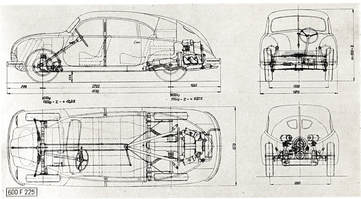
Interior heating: warm air from the engine in double floor channels exiting in grilles under the front seats. The pipework from the engine compartment to the double floor channels is shown shaded.
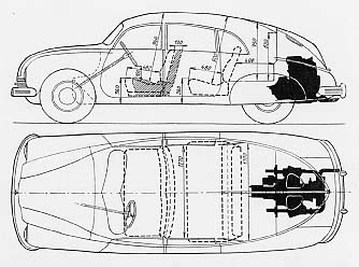
The front boot has space for two spare wheels – the extra weight improves front to rear weight ratio.
Front to rear weight ratio: 44% to 56% (empty), 42.8% to 57.2% (with full load of 405kg).
Front to rear weight ratio: 44% to 56% (empty), 42.8% to 57.2% (with full load of 405kg).
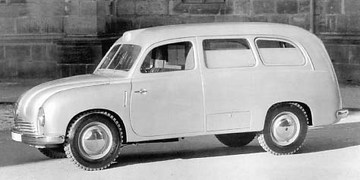
Tatraplan derivatives:
1949 Tatra T201 ambulance (Sodomka/Karosa body made in Jaroměř - formerly Hartmann & Sons, all photos taken at Vysoké Mýto), later series front engine, 1 unit only (the 1949 original body damaged in an accident, and then reconstructed with an amended front bonnet, shorter rear doors and varied stretcher details at Karosa in 1950), front engine on central tubular chassis driving rear wheels.
1949 Tatra T201 ambulance (Sodomka/Karosa body made in Jaroměř - formerly Hartmann & Sons, all photos taken at Vysoké Mýto), later series front engine, 1 unit only (the 1949 original body damaged in an accident, and then reconstructed with an amended front bonnet, shorter rear doors and varied stretcher details at Karosa in 1950), front engine on central tubular chassis driving rear wheels.
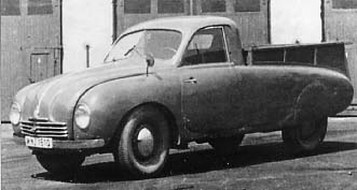
1949 Tatra T201 'Dakota' pick-up prototype with first series front engine on central tubular chassis driving rear wheels, 1 unit. Used as a service vehicle to accompany Tatra rally teams.
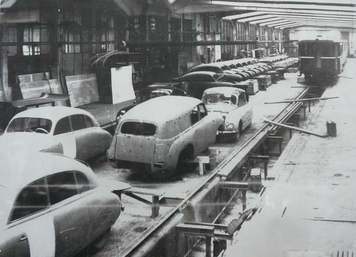
1949 Special Tatraplan T201 front engine prototype van body on a central tubular chassis in the Tatra factory workshop, designed by Josef Klejch at Karosa, Vysoké Mýto. 1 to 3 two- and four-door units made; one 4-door unit survives in the Czech Republic. That unit was possibly later converted to a police vehicle in the 'Šťastnou cestu' film (1962), but its present colour is silver metallic.
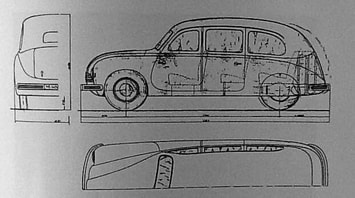
Proposal for a T201 type 6 to 9-seater body.
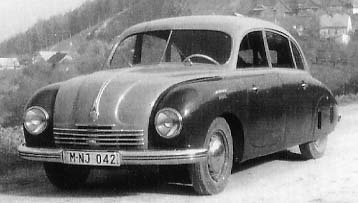
1949–53 Tatra T600D Tatraplan Diesel, with two types of rear aircooled diesel engines, 2 – 3 units?
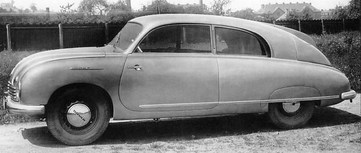
1949-58 Tatra T601 Tatraplan Monte Carlo Coupé, 1 unit only, in various aluminium body versions, rear side windows air intake, various engines installed, the latest version with a T603 A 2545cc engine with grilles in the rear lid.
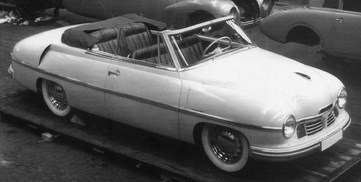
1949 Tatraplan Cabriolet, Sodomka body, 1 unit.
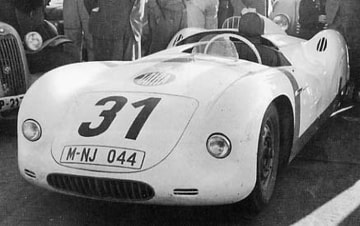
1949 Tatra T602 Tatraplan Sport, 2 units, engine turned facing the front, in front of rear axle.
Competitions:
Factory prepared racing Tatraplans, usually painted yellow or grey, had sealed rear doors without handles to lighten and stiffen the car and engines with increased compression ratio 6.8:1 with two dual Solex 30 AAIP carburettors, new 260 degrees camshaft, valves and rocker arms resulting in increased power to 67bhp, otherwise the cars retained normal serially produced specification.
1948 Jeseníky, Czechoslovakia: gold medal, driver: Alois Kopečný.
1949 Jeseníky, Czechoslovakia: first, third and fourth places, winning drivers: no. 75 Josef Chovanec / Antonín Kubíček.
1949 Velká Jihočeská soutěž, Czechoslovakia: first place in both classes below and above 2000cc, winning drivers: Adolf Veřmiřovský and Bruno Sojka in a Tatraplan with a four-cylinder T900 engine of 2437cc and 64hp.
1949 Tatranská automobilová a motocyklová soutěž, Starý Smokovec, Czechoslovakia: first three in 2000cc category: winning drivers in light brown Tatraplans: Josef Chovanec / Jaroslav Pavelka, Adolf Veřmiřovský / Augustin Jeřábek, Alois Kopečný / Antonín Kubíček.
1949 Internationale Österreichische Alpenfahrt: 1056 km, first four places gained in yellow Tatraplans; out of 22 cars in 2000cc Touring car class, drivers team: no. 117 in the T601: Karel Vrdlovec / Vladimír Formánek (Alpine Cup winner), no. 114 in a T600: Jaroslav Pavelka / Josef Chovanec, no. 115 in a T600: Adolf Veřmiřovský / Ing Schedivý, no. 116 in a T600: Alois Kopečný / Antonín Kubíček, team manager Josef Veřmiřovský.
1950 Rallye Interlaken: third and fourth places, no. 38 in a T600: Kopečný / Kubíček, no. 39 in the T601: Pavelka / Zahradníček.
1951 Internationale Österreichische Alpenfahrt: 1375km, first in Touring car class: Alois Kopečný / Jan Kubíček, (Alpine Cup winner).
1951 Langa-Langa Gilgil, Nairobi: winner of its class, equal time to the fastest.
10/06/1951 80 km race, Bosque de Chapultepec in Mexico City: first place, 42m 41s, 112.341 km/h, driver: Jean Trévoux.
1953 Coronation Safari: Kenya, Uganda & Tanganyika: first in class C, drivers: Vic R. Preston Sr and D. P. Marwaha.
Factory prepared racing Tatraplans, usually painted yellow or grey, had sealed rear doors without handles to lighten and stiffen the car and engines with increased compression ratio 6.8:1 with two dual Solex 30 AAIP carburettors, new 260 degrees camshaft, valves and rocker arms resulting in increased power to 67bhp, otherwise the cars retained normal serially produced specification.
1948 Jeseníky, Czechoslovakia: gold medal, driver: Alois Kopečný.
1949 Jeseníky, Czechoslovakia: first, third and fourth places, winning drivers: no. 75 Josef Chovanec / Antonín Kubíček.
1949 Velká Jihočeská soutěž, Czechoslovakia: first place in both classes below and above 2000cc, winning drivers: Adolf Veřmiřovský and Bruno Sojka in a Tatraplan with a four-cylinder T900 engine of 2437cc and 64hp.
1949 Tatranská automobilová a motocyklová soutěž, Starý Smokovec, Czechoslovakia: first three in 2000cc category: winning drivers in light brown Tatraplans: Josef Chovanec / Jaroslav Pavelka, Adolf Veřmiřovský / Augustin Jeřábek, Alois Kopečný / Antonín Kubíček.
1949 Internationale Österreichische Alpenfahrt: 1056 km, first four places gained in yellow Tatraplans; out of 22 cars in 2000cc Touring car class, drivers team: no. 117 in the T601: Karel Vrdlovec / Vladimír Formánek (Alpine Cup winner), no. 114 in a T600: Jaroslav Pavelka / Josef Chovanec, no. 115 in a T600: Adolf Veřmiřovský / Ing Schedivý, no. 116 in a T600: Alois Kopečný / Antonín Kubíček, team manager Josef Veřmiřovský.
1950 Rallye Interlaken: third and fourth places, no. 38 in a T600: Kopečný / Kubíček, no. 39 in the T601: Pavelka / Zahradníček.
1951 Internationale Österreichische Alpenfahrt: 1375km, first in Touring car class: Alois Kopečný / Jan Kubíček, (Alpine Cup winner).
1951 Langa-Langa Gilgil, Nairobi: winner of its class, equal time to the fastest.
10/06/1951 80 km race, Bosque de Chapultepec in Mexico City: first place, 42m 41s, 112.341 km/h, driver: Jean Trévoux.
1953 Coronation Safari: Kenya, Uganda & Tanganyika: first in class C, drivers: Vic R. Preston Sr and D. P. Marwaha.
